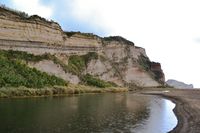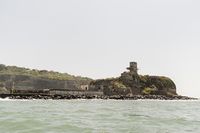Monte di Procida Coast: Difference between revisions
| Line 46: | Line 46: | ||
=== Land use === | === Land use === | ||
Monte di Procida is mainly dedicated to agriculture, as the rest of the Phlegraean Fields: it should be noted the importance of one of the most ancient vine in Campania that is connected to the production of the ''Falanghina'' wine, exported even to the United States. Besides the cultivated fields, the area is quite urbanised, even if the illegal development of the city is a serious problem that compromises its landscape value. Neverthless, tourism is still a cornerstone of the local economy. The coast, with its important port activity, attracts tourists interested in the Acquamorta beach and in nature walk in the Torrefumo natural oasis, but also in visits to cultural sites, in fact the area is part of the Phlegraean Fields' Archeological Park. | Monte di Procida is mainly dedicated to agriculture, as the rest of the Phlegraean Fields: it should be noted the importance of one of the most ancient vine in Campania that is connected to the production of the ''Falanghina'' wine, exported even to the United States. Besides the cultivated fields, the area is quite urbanised, even if the illegal development of the city is a serious problem that compromises its landscape value. Neverthless, tourism is still a cornerstone of the local economy. The coast, with its important port activity, is an essential social gathering place; moreover, it attracts tourists interested in the Acquamorta beach and in nature walk in the Torrefumo natural oasis, but also in visits to cultural sites, in fact the area is part of the Phlegraean Fields' Archeological Park. | ||
<gallery caption=" " widths="200px" heights="150px" perrow="5"> | <gallery caption=" " widths="200px" heights="150px" perrow="5"> | ||
Revision as of 18:27, 15 April 2018
>>>back to working groups overview
Rationale
The area of Monte di Procida is as fascinating as it is complex because of the delicate interpenetration between its natural and anthropic aspects. Its coast is strongly characterised by a tufa ridge that has an incredible value as an essential landscape value and a symbol of the geological evolution of the site, even if it has been defaced from property speculation and illegal buildings. However, this place is a central point in the local connection system thanks to its port activity. An environmental improvement accompanied by a project for new sustainable infrastructures could be the solution to protect this valuable area, incentivizing its development.
Location and scope
You can edit this map with the map editor
A Landscape System Analysis
A.1 Landscape layers and their system context
Geomorphology, landscape units and coastal typology
The site of Monte di Procida was generated 35000 to 10500 years ago from the collapse of the Phlegraean Fields' caldera, a semicircular depression in which a complex volcanic system rose. During the centuries, the area of study has been constantly molded from deposits from volcanic eruptions and phenomena of erosion. In fact the coastal morphology is characterised from different layers of rock sedimentation, from the lowest and most ancient part, composed of ashes and lapilli, to the highest and most recent one, that consist of pumice and tufa from the Museum Breccia, made of large blocks of stone. Anyway, the coastline, that hosts wide sand beach of Acquamorta, is under constant threat from landslides: the Torrefumo natural oasis has the task of preserving the ridge from erosion. Another important element of the coastal landscape system is the San Martino islet, mainly composed of pozzolana, that broke off the land in 1488 because of a seaquake.
Land use
Monte di Procida is mainly dedicated to agriculture, as the rest of the Phlegraean Fields: it should be noted the importance of one of the most ancient vine in Campania that is connected to the production of the Falanghina wine, exported even to the United States. Besides the cultivated fields, the area is quite urbanised, even if the illegal development of the city is a serious problem that compromises its landscape value. Neverthless, tourism is still a cornerstone of the local economy. The coast, with its important port activity, is an essential social gathering place; moreover, it attracts tourists interested in the Acquamorta beach and in nature walk in the Torrefumo natural oasis, but also in visits to cultural sites, in fact the area is part of the Phlegraean Fields' Archeological Park.
- Yourcase landuse1.jpg
add a caption
- Yourcase landscapeunits2.jpg
add a caption
- Yourcase landscapeunit3.jpg
add a caption
Green/blue infrastructure
According to the current urban plans of the area, Monte di Procida has already been involved in the project of green and blue infrastructure. In particular, the Torrefumo site has become an ecological corridor in order to preserve the high natural character of the area, improving habitats for wildlife and protecting particular ecosystems like the cane field at the bottom of the ridge; moreover, thanks to the creation of artificial reefs, it prevents the high tide from flooding the coast.
- Your case green blue infrastructure1.jpg
add a caption
- Your case green blue infrastructure2.jpg
add a caption
Actors and stakeholders
- Who is driving changes in this landscape? Who is affected by those changes?
- Draw a stakeholder and/or power map: Who is affected highly but with low power? Who has high power but is not affected?
- Your case your powermap.jpg
add a caption
Sacred spaces and heritage
- Which places/elements hold cultural value and to whom?
- You may add a map and some images, please also explain in your caption why these elements are valuable
- Your case sacredspace1.jpg
add a caption
- Your case sacredspace2.jpg
add a caption
- Your case sacredspace3.jpg
add a caption
Visual appearance and landscape narrative
- Which elements are essential for the landscape character?
- Has the landscape been painted or otherwise depicted, when and whom? Which elements are essential?
- Which narratives exist? Who has written about this landscape or depicted it in some way?
- You can add text and images
- Your case character1.jpg
add a caption
- Your case character2.jpg
add a caption
- Your case character3.jpg
add a caption
A.2 Summary of you landscape system analysis and your development Targets
- You can summarize your findings with an DPSI(R) Model or a Spider Diagram
- Link back to the Sustainable Development Goals: Which goals are at risk?
- What is your hypothesis for this landscape?
- Visualise your hypothesis with one graphic/pict
- Are there any existing initiatives taking action in this landscape? Do you have a critical perspective on that?
- Add text and visuals
- Your case your spider diagram or dpsir model.jpg
explain your analysis briefly in the caption
- Your case your hypothesis visual.jpg
explain your hypthesis briefly in the caption
A.3 Theory reflection
- Reflect on at least three international policy documents in relation to their local landscape case
- choose one international, one European and one national document
- You can choose references from our reading list
- Scope: 250 words
A.4 References
- Una passeggiata lungo la costa di Monte di Procida e non solo...
- Comune di Monte di Procida
- PUC, RUEC e Rapporto Ambientale per la Valutazione Ambientale Strategica
- Building a Green Infrastructure for Europe
- Towards a Green Infrastructure for Europe. Developing new concepts for integrations of Natura 2000 network into a broader countryside
- Parco archeologico dei Campi Flegrei - Necropoli di Cappella
Phase B: Landscape Evaluation and Assessment
B.1 Assessment Strategy
- Based on the hypothesis derived from your previous landscape systems analysis you are now asked to define the goals for assessing the landscape. Your assessment is the basis for evaluating the landscape status.
- Which elements and phenomena need to be mapped, why and how?
- This a text contribution, max 250 words
B.2 Mapping
- As defined by your assessment strategy you conduct the mapping and present your findings here
- As a minimum, at least three different themes need to be mapped, you may choose more if needed
- Your case your assessment mapping themel.jpg
briefly explain the findings of your mapping
- Your case your assessment mapping theme2.jpg
briefly explain the findings of your mapping
- Your case your assessment mapping theme3.jpg
briefly explain the findings of your mapping
B.3 Problem definition and priority setting
- Give a summary of the major findings of your mapping process, what are the problems/potentials identified?
- Draw a problems/potentials map
- Set priorities for the most relevant issues
- Your case problems potentials map.jpg
add caption here
B.4 Theory reflection
- Please reflect the assessment and evaluation methods used based on at least three readings
- Did you encounter limitations'
- 200 words test contribution
B.5 References
- give a full list of the references you have used for this section
Phase C – Strategy and Master Plan
C.1 Goal Setting
- Define strategic planning objectives based on the evaluation findings
- Link back to your original targets from section one and the Development Goals
- 150 words text contribution
C.2 Spatial Strategy and Transect
- translate your strategic goals into a vision
- develop a spatial translation of your vision
- exemplify your vision in the form of a transect with concrete interventions
- add map(s) and visualizations
- Your case spatial translaton vision.jpg
add caption here
- Your case transect.jpg
add caption here
- Your case transect detail1.jpg
add caption here
- Your case transect detail2.jpg
add caption here
C.3 From Theory of Change to Implementation
- For implementing your vision: Which partnerships are needed? Which governance model is required?
- Who needs to act and how? Draw and explain a change/process model/timeline
- Which resources are needed? On which assets can you build?
- add 150 words text and visuals
- Your case spatial your governance model.jpg
add caption here
- Your case spatial your process model.jpg
add caption here
C.4 References
- give a full list of the references you have used for this section
D. Process Reflection
- Reflect in your intercultural and interdisciplinary team on the outcomes of your study
- Which limitations were you facing?
- What have you learnt from each other?
- What would you do differently next time?
- You can also use diagrams/visuals
- 250 words text


